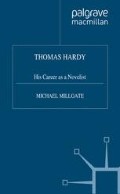Abstract
When A Pair of Blue Eyes appeared in its three-volume form in May 1873 Hardy’s professional status was confirmed by the appearance of his name on a title-page for the first time. That status had earlier been signalled by his decision to abandon his architectural career, and by an invitation from Leslie Stephen to write a serial for the Cornhill. When Stephen wrote, on November 30, 1872, Hardy was ready with a suggestion for “a pastoral tale”, though he seems to have reported only the title, Far from the Madding Crowd, and the occupations of the chief characters.1 It was in the spring of 1873, following the completion of A Pair of Blue Eyes and a renewed enquiry from Stephen, that Hardy began serious work on the novel. Stephen accepted it at the beginning of that October on the evidence of the specimen chapters Hardy sent him; shortly afterwards Hardy agreed to an earlier publication date than had originally been contemplated, and the first part appeared in the Cornhill for January 1874. The novel was still far from completion at this point, and Hardy only finished work on it that summer.2 The two-volume first edition appeared on November 23, 1874, Hardy having returned the proofs—with “very few” corrections, mainly to the opening chapter—to Smith, Elder on October 9, modestly requesting in the accompanying letter that his name be allowed to appear in “the announcement of the book”.3
Access this chapter
Tax calculation will be finalised at checkout
Purchases are for personal use only
Preview
Unable to display preview. Download preview PDF.
Notes
Frederick William Maitland, The Life and Letters of Leslie Stephen (London, 1906), p. 271; for Stephen’s letter see Maitland, pp. 270–71 (complete text in Purdy, pp. 336–337).
Hardy to Harrison, July 29, 1901 (Univ. of Texas, quoted in Ann Bowden, ‘The Thomas Hardy Collection’, Library Chronicle of the University of Texas, 7, ii (1962), p. 10.
Grolier Cat, p. 15, lists a copy of Infantry Sword Exercises (published by H.M. Stationery Office, 1873) with Hardy’s signature on the title page; Hardy also owned (1938 Wreden catalogue, item 342) Instructions for the Sword, Carbine, Pistol, and Lance Exercisc; together with Field Gun Drill. For the Use of the Cavalry (London, 1871). Since Troy was a cavalryman, the latter volume (published by the Adjutant General’s Office, Horse Guards) seems the more relevant, and the instructions there for the cavalry sword exercise (pp. 8–22) were probably the immediate source of Hardy’s descriptive details. They also clarify Troy’s remark, ‘This may be called Fort meeting Feeble, hey, Boldwood?’ (267): ‘The recruit having been perfectly instructed in drawing and returning his sword, will now be made acquainted with the strong and weak parts of it; the “Fort” (strong) being the half of the blade near the hilt, the “Feeble” (weak), the half towards the point. … From the hilt upwards, in opposing the blade of an adversary, the strength of the defence decreases in proportion as the cut is received towards the point; and vice versa, it increases from the point downwards’ (pp. 10–11). Cf. R. L. Purdy, ed., Far from the Madding Crowd (Boston, 1957), p. 207, n. 1.
See Richard C. Carpenter, ‘The Mirror and the Sword: Imagery in Far from the Madding Crowd’, Nineteenth Century Fiction, 18 (1964), 342–345.
Albert Mordell, ed., Literary Reviews and Essays by Henry James (New York, 1958), p. 294; review also quoted in Thomas Hardy and His Readers, pp. 28–33.
May O’Rourke, Thomas Hardy: His Secretary Remembers (Beaminster, Dorset, 1965), p. 21.
Hardy was responding to Miss O’Rourke’s suggestion that Stinsford was ‘a Gray’s Elegy sort of place’. The Elegy’s image of village life is, of course, far from idyllic, and Hardy may conceivably have been influenced in his choice of title by a passage in Francis George Heath, The ‘Romance’ of Peasant Life in the West of England (London, 1872), p. 6. Heath is concerned to challenge the assumption of city-dwellers that poverty and distress are peculiarly urban phenomena: ‘as we wander by gurgling brooks, and through sylvan glades, and listen to the sweet songs of the birds, and see the glad sights which a wise and benificent Creator has spread over the earth, and which are to be seen nowhere in such perfection as they are to be found “Far from the madding crowd’s ignoble strife,” we cannot imagine that aught but happiness and contentment are the lot of the rustic swain. But nearly all of our native poets in their descriptions of English pastoral life have deceived us by their rosecoloured pictures of the peasants.’ On pp. 7–8 Heath uses phrases from the Elegy to stress less happy aspects of the labourer’s situation and to introduce a discussion of current conditions in Dorsetshire.
See, for example, Hermann Lea, Thomas Hardy’s Wessex (London, 1913), pp. 43–44.
Roy Morrell, Thomas Hardy: The Will and the Way (Kuala Lumpur, 1965), p. 59, quotes the opening of the final paragraph of chapter 56 (456) and comments: ‘Ahead of Gabriel and Bathsheba is no romance, but a reality that Hardy represents as more valuable, a reality of hard and good work on the two farms.’
Copyright information
© 1994 Michael Millgate
About this chapter
Cite this chapter
Millgate, M. (1994). Far from the Madding Crowd. In: Thomas Hardy. Palgrave Macmillan, London. https://doi.org/10.1057/9780230379534_7
Download citation
DOI: https://doi.org/10.1057/9780230379534_7
Publisher Name: Palgrave Macmillan, London
Print ISBN: 978-0-333-62316-9
Online ISBN: 978-0-230-37953-4
eBook Packages: Palgrave Literature & Performing Arts CollectionLiterature, Cultural and Media Studies (R0)

